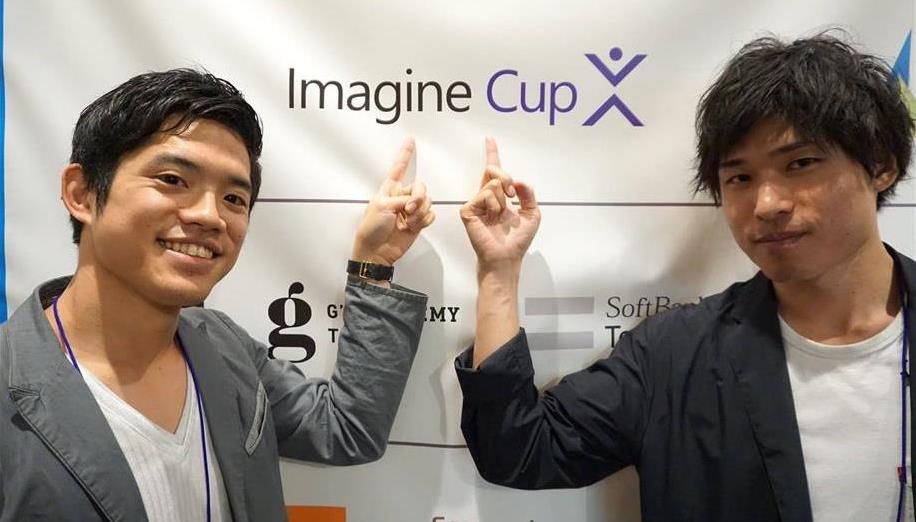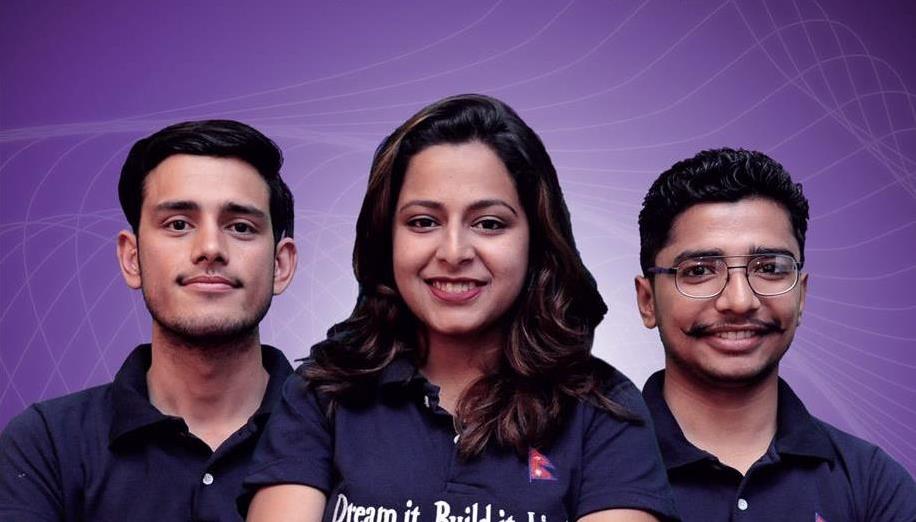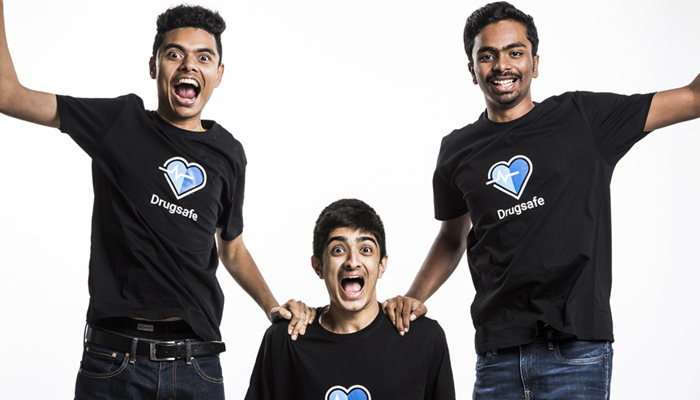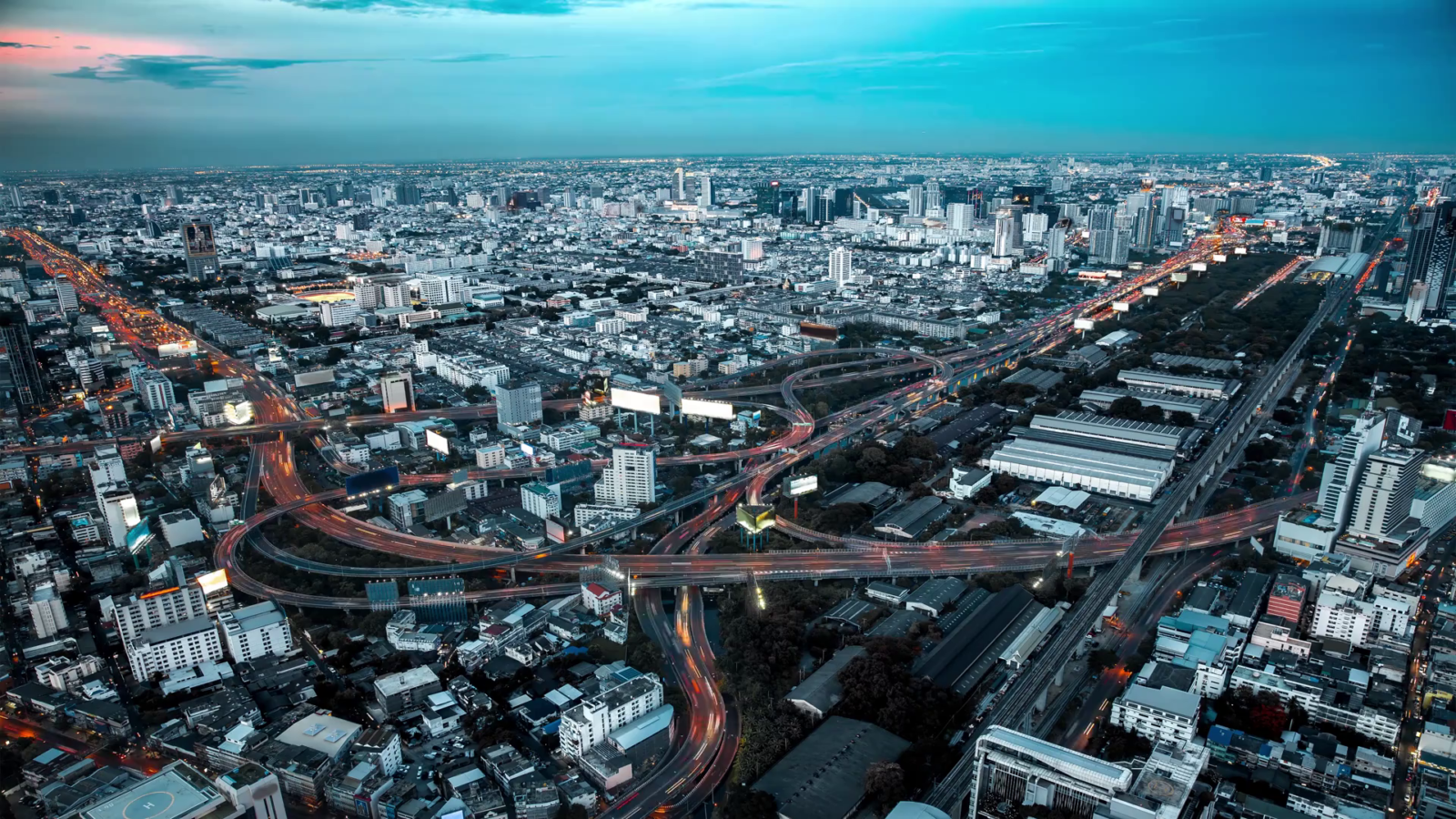
Empowering Asia Pacific’s Digital Ambition
Asia Pacific is a vibrant epicenter of global economic activity and home to more than 60 per cent of the world’s young people. No wonder the region has an ambitious eye on the future – its estimated 750 million young women and men, aged between 15 to 24 years, are better educated and skilled than ever before.
Aspirational and ready for change like its youth, the economies of our region are already generating unprecedented GDP growth and enthusiastically embracing emerging digital technologies as tickets to an even brighter future – where low-end manufacturing will progressively make way for high-value, knowledge-based industries with global reach.
A study we produced in partnership with IDC Asia/Pacific predicted that that by 2021, approximately 60% of Asia’s GDP will come from products and services created through digital transformation – representing an estimated USD1.16 trillion windfall to regional economic growth.
Much of Asia Pacific’s new digital landscape will be shaped by the rise of the intelligent cloud and intelligent edge. The intelligent cloud is ubiquitous computing that is enabled by the public cloud and artificial intelligence (AI). Around it is the intelligent edge, which is a continually expanding set of connected systems and devices that gather and analyze data – close to the users, the data, or both. Together, they provide the ability to create a new class of distributed, connected applications and, ultimately, breakthrough business outcomes.
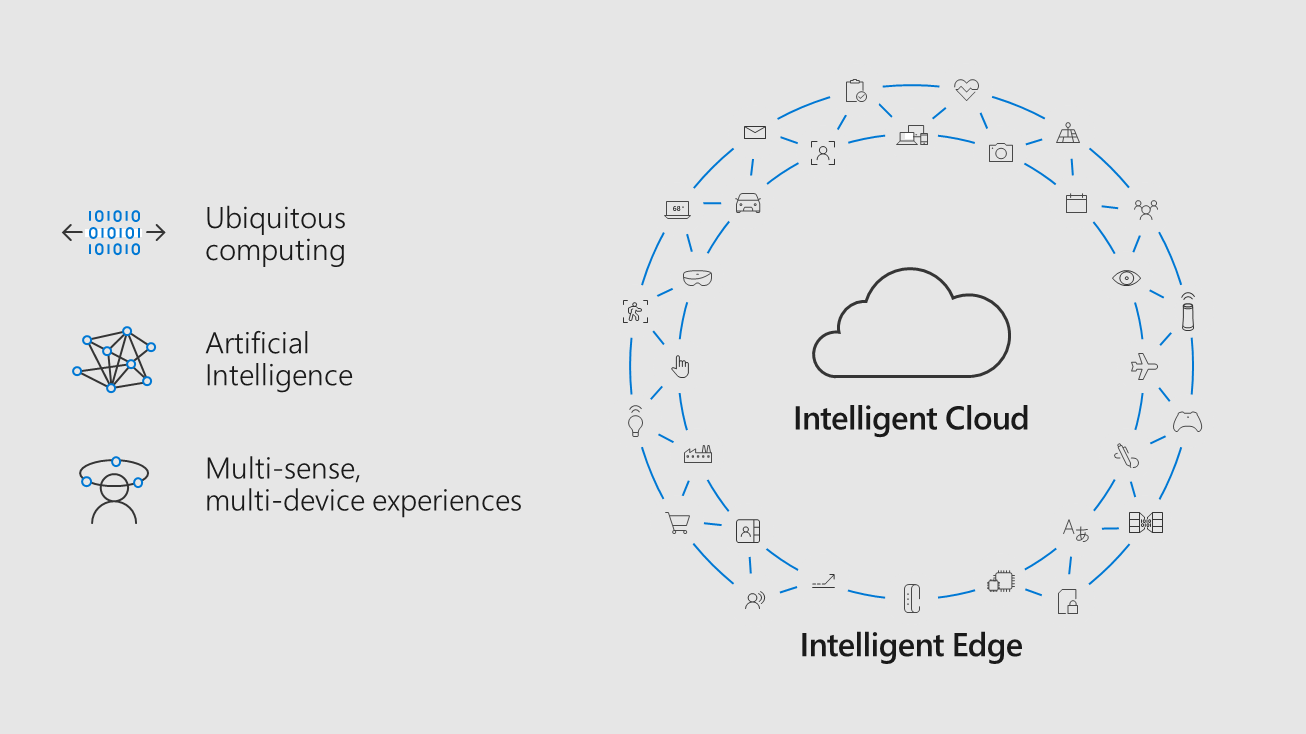
At Microsoft, our mission is to create technology to empower every person and every organization on the planet to achieve more. In Asia Pacific, we work closely with governments, non-government organizations, enterprises, communities, and individuals to deliver on this mission and realize the region’s digital ambitions.
Growing in and with Asia Pacific
Microsoft started operating in Asia Pacific more than 30 years ago and today we have 20,000 employees in 20 markets.
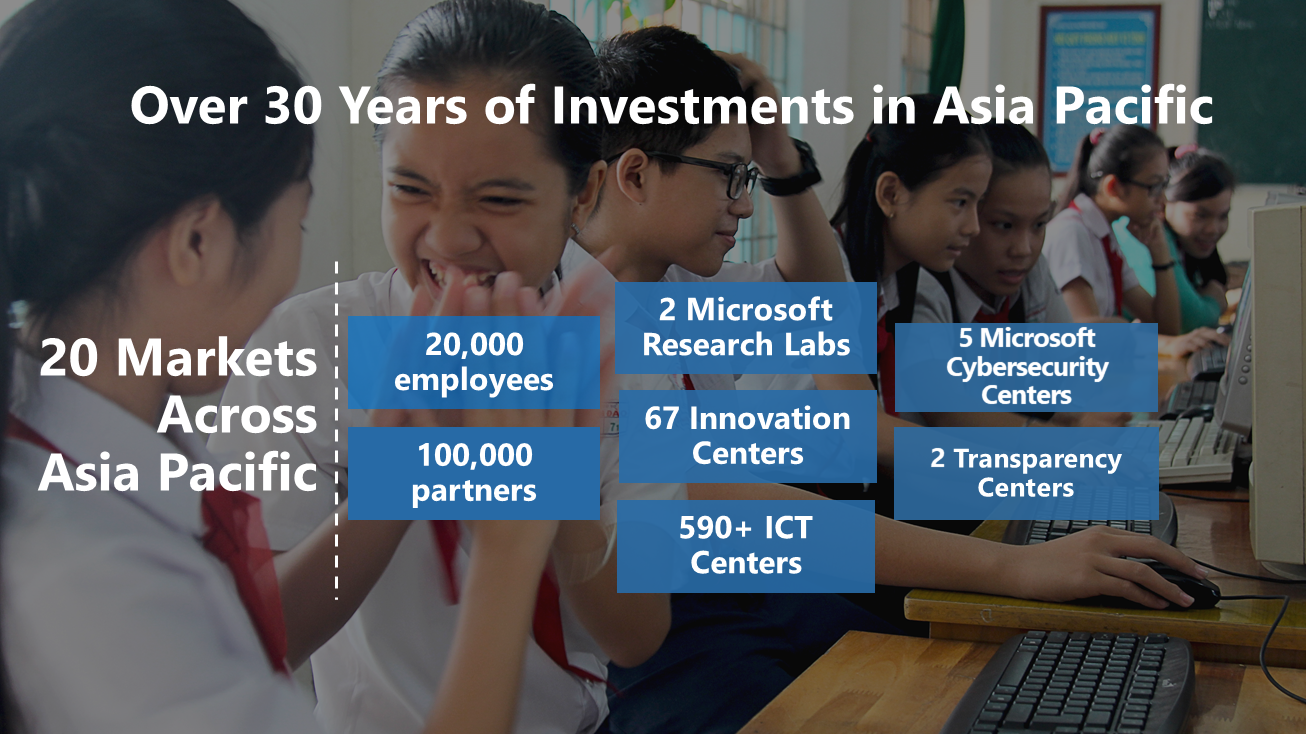
Microsoft also has more than 100,000 partners who work with us to deploy our products and services as well as train and support customers. Many are also creating new applications based on our cloud platform and development tools.
We have been here every step of the way as the markets in the region transformed into the vibrant economies we see today. And we continue to invest in driving growth and transformation in Asia Pacific.
Innovating for a better future
At Microsoft, we don’t celebrate technology for technology’s sake. Instead, we celebrate what others create and build with technology. We are committed to being the catalyst for breakthroughs with the potential for global impact.
Globally, we invested around US$13 billion on R&D in 2017. In Asia Pacific, we have more than 67 Innovation Centers, which support promising technology initiatives, help innovators bring their transformative solutions to market, and launch new local start-ups. We also have significant research investments in the region, including:
Microsoft Research India in Bangalore, India, focuses on cutting-edge research in areas such as theoretical computer science (algorithms, cryptography), systems (distributed systems and networking, programming languages and tools, security and privacy), machine learning and AI, natural language processing, human-computer interaction, and applications of technology that aim to address societal problems.
Microsoft Research Asia (MSRA) in Beijing, China, is our fundamental research arm in this region. It drives advances in next-generation revolutionary technologies as well as future computing research in fields such as AI, natural user interface, computer vision and more. Founded in 1998, MSRA recently celebrated its 20th anniversary. It is our largest R&D institute outside of North America and boasts a long list of AI-related breakthroughs.
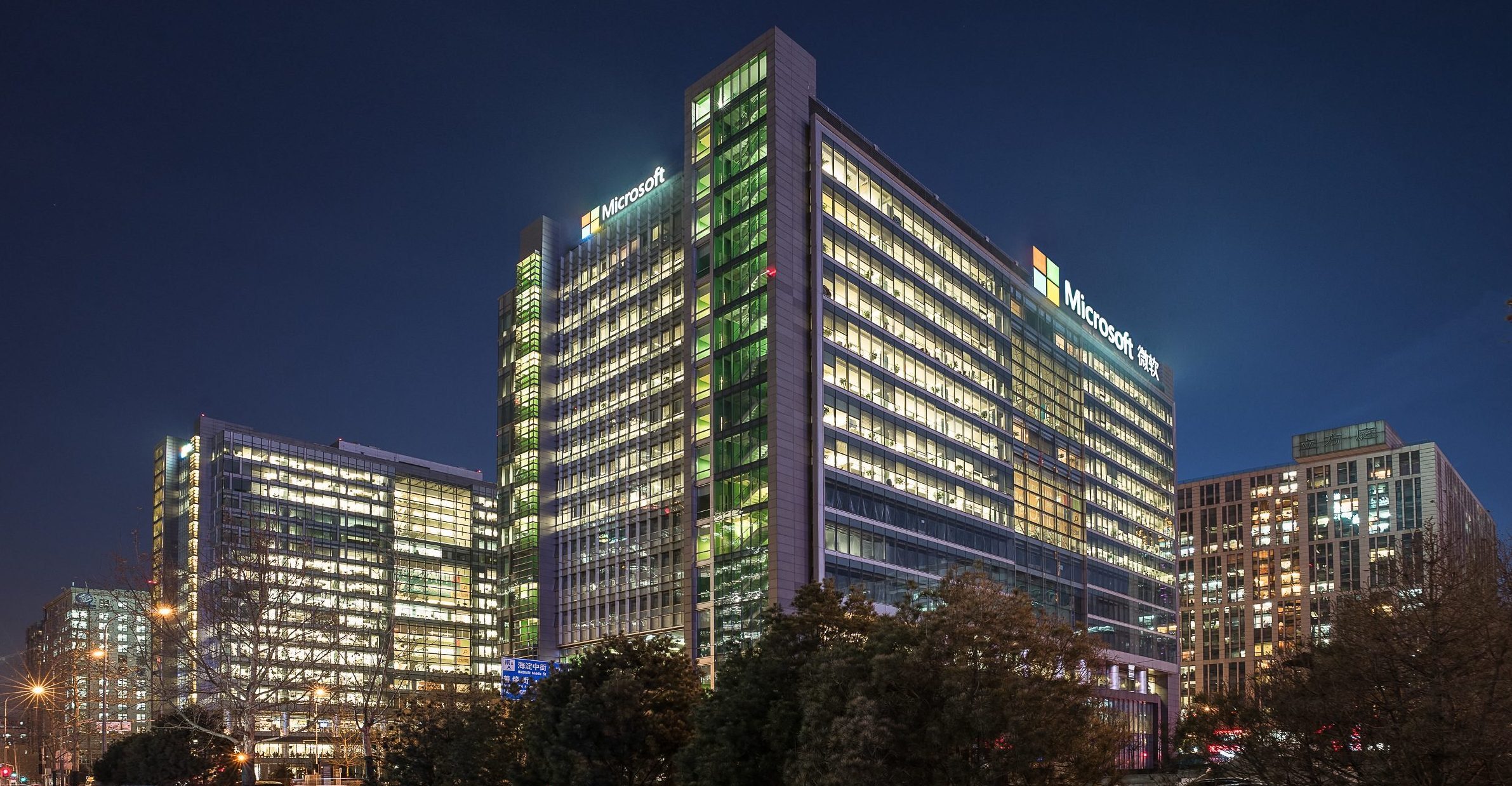
Microsoft is the first technology company to achieve human parity – meaning achieving the same quality and accuracy as a typical human – in four key areas: image recognition, machine reading comprehension, conversational speech recognition and English-to-Chinese news translation. MSRA researchers have contributed heavily to these AI achievements.

Drawing upon the work in AI research, XiaoIce, Microsoft’s incredibly popular social chatbot in China, has been updated with ‘full duplex voice sense’. This is yet another technological breakthrough by Microsoft that allows people to have a conversation with an AI-powered chatbot in a natural way, much like how a person is chatting on the phone with a friend. XiaoIce has also ventured into the world of fashion, with new capabilities to create patterns based on words, themes or key colors.
AI is clearly a key research focus for Microsoft in Asia Pacific. The Microsoft-IDC “Unlocking the Economic Impact of Digital Transformation in Asia Pacific” study also found that AI would be the main catalyst for growth and is top of mind for business leaders investing in emerging technologies.
Furthering our investments in AI innovation, we announced the establishment of Microsoft Research Asia-Shanghai and the Microsoft-INESA AI Innovation Center at the Shanghai Xuhui District in September 2018. A strategic Memorandum of Understanding (MoU) was signed at the World AI Conference 2018 in Shanghai by the Shanghai Xuhui District People’s Government, INESA Group and Microsoft for the creation of the two entities. Aimed at driving the digital transformation of government and enterprises, the Microsoft Research Asia-Shanghai and Microsoft-INESA AI Innovation Center will promote the development of AI technology and the growth of AI industry in Shanghai through innovative cooperation.
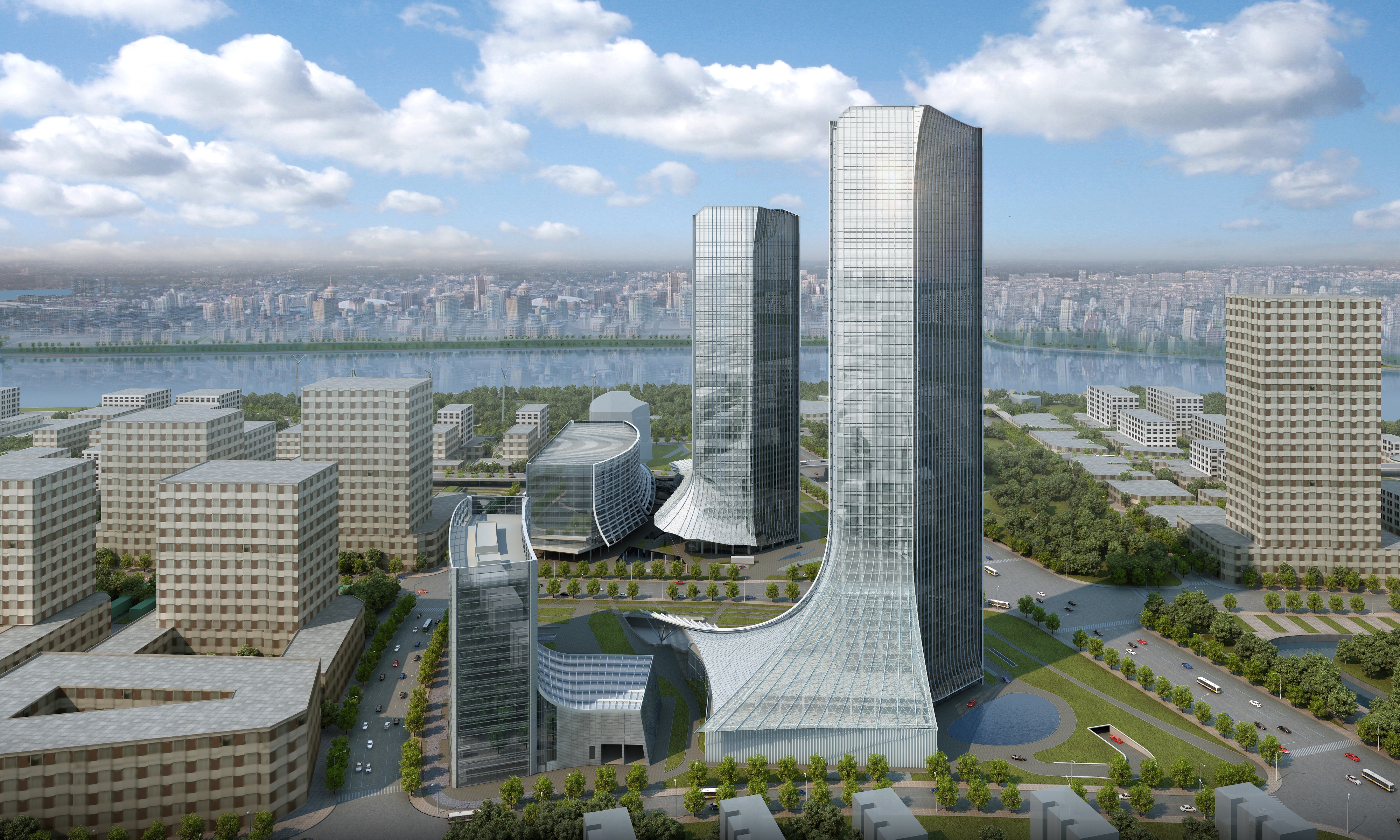
Microsoft has also announced a US$33 million investment to create an AI R&D Hub in Taiwan to transform the island’s technology and industrial sectors. This center will have a 100-strong research team within two years, doubling to 200 within five years.
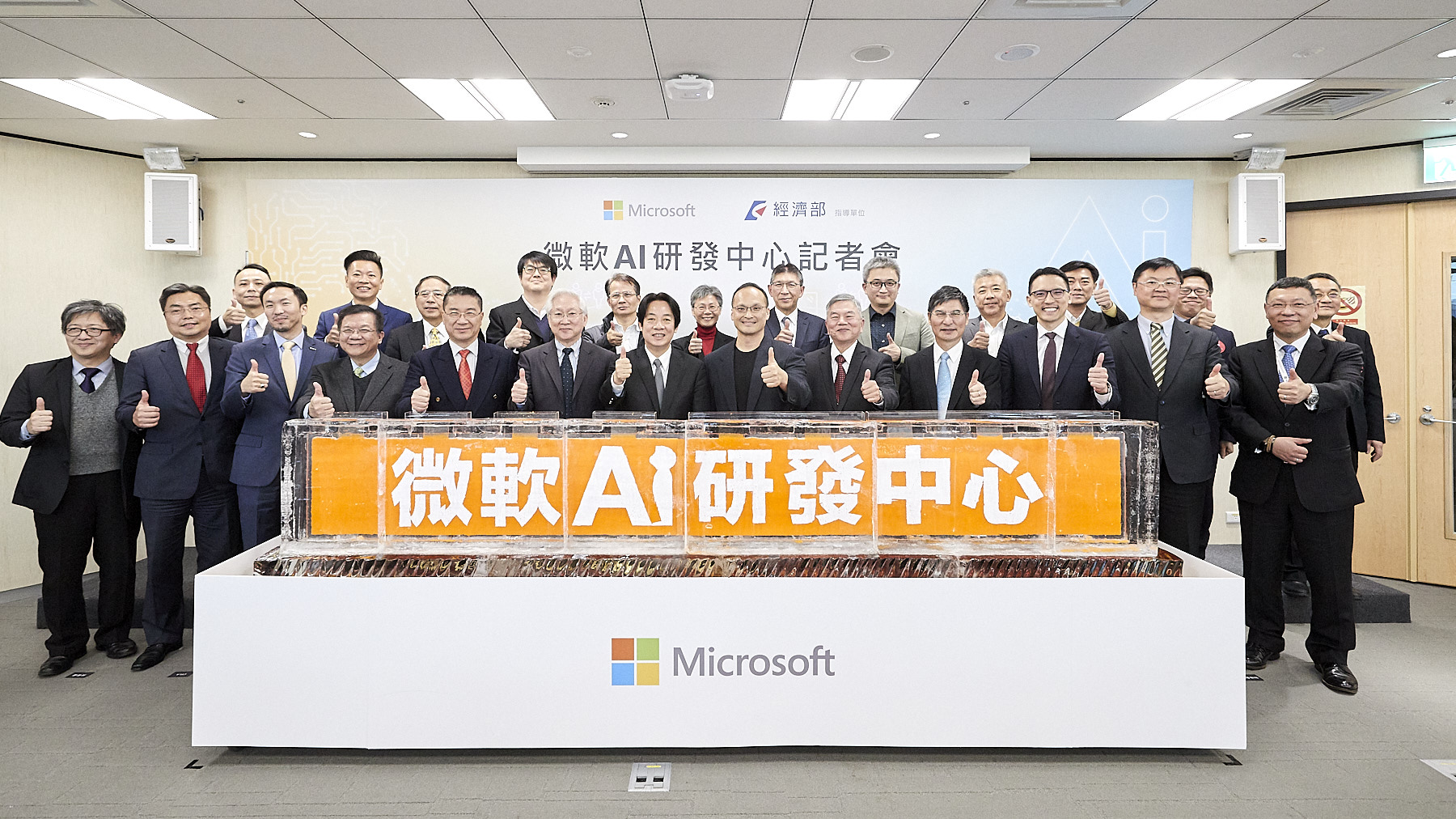
Breakthroughs in AI are already bearing fruit in the real world with organizations in Asia Pacific serving their customers in innovative ways. For example, in Japan, Red Sea Bream has been prized since ancient times for its coppery skin and delicious firm white flesh. Now, with the demand for sushi and sashimi booming more than ever, marine researchers are turning to Microsoft technologies to make sure there is enough fish to meet the nation’s appetite. The Kindai University’s Aquaculture Research Institute in Japan is using AI, machine learning, and IoT to speed up the laborious, but essential chore, of fish sorting.
We also understand the importance of empowering Asia’s innovators of the future – the smart, curious and ambitious youngsters who have the desire to dream big, code creatively, and boldly bring their ideas to life.
Microsoft’s Imagine Cup, an annual global competition, empowers the next generation of computer science students to team up and use their creativity, passion, and knowledge to create applications that promise to shape how we will live, work and play in the future
At Imagine Cup 2018, young innovators from Asia Pacific focused on challenges and problems in agriculture, environmental sustainability, and healthcare.
- Japan’s Team Mediated Ear clinched third place globally with an AI-powered software to help the hearing impaired.
- Team Sochware from Nepal won the AI Award for a solution the helps farmers grow more crops with higher yields.
- Team DrugSafe from India won the Big Data Award with a solution that lets consumers identify whether medications are genuine or counterfeit.
Using AI for Good
The power of AI promises to usher in exciting new ways to address critical world challenges – in healthcare, conservation, sustainability, accessibility, disaster recovery and more.
Recognizing this, Microsoft has launched several programs under AI for Good – a US$115 million, five-year commitment. This includes AI for Earth, AI for Accessibility and the recently announced AI for Humanitarian Action. As part of these initiatives, Microsoft works closely with selected NGOs, researchers and organizations, offering financial grants, technology investments, and partnerships to accelerate innovation and speed impact.
Microsoft is passionate about creating products and tools with the potential to transform our lives for the better. In Asia Pacific, we have been putting our AI expertise to good use – in innovative ways.
On March 11, 2011, the Great East Japan Earthquake, one of the most powerful ever recorded, shook the country’s north-eastern coast near Tohoku and triggered a tsunami that killed nearly 20,000 people. Japan sits on the world’s most active earthquake belt and is now looking to AI as a tool to prepare for more quakes and recover from future disasters. AI for Earth recipient, Bai Yanbing, a post-doctoral researcher at Tohoku University has developed a Microsoft Azure-based Rapid Damage Map utilising image recognition and Microsoft’s Cognitive Toolkit. When responding to a disaster, time is always of the essence. With this improved, more accurate damage mapping technology, authorities and relief workers stand a better chance of saving more lives when the next earthquake hits.
In China, more than 70,000 families are looking for their missing children. Using Microsoft AI solutions, China-based NGO Baby Come Home was able to find Yesong Wang, who disappeared four years ago from a busy market. Developed as part of a 2015 Microsoft Hackathon effort, the Photo Missing Children (PhotoMC) application, based on Microsoft’s Cognitive Services, uses facial recognition technology to project what children might look like years into the future, and matches this with photos from families searching to find their loved ones.

The AI for Accessibility initiative has made a huge impact in Asia Pacific, which is home to 690 million people with disabilities. Breakthroughs in AI technologies can now enable people with vision, hearing, cognitive, learning, and mobility disabilities to perform daily tasks more independently. They lead richer, more productive, lives and can participate more fully in society.
Microsoft worked with Vision Australia, a non-profit organization and a leading provider of services for the visually impaired, to develop Soundscape. This AI-powered app uses 3D audio and GPS-based location awareness to provide its users with an array of information about their surroundings.
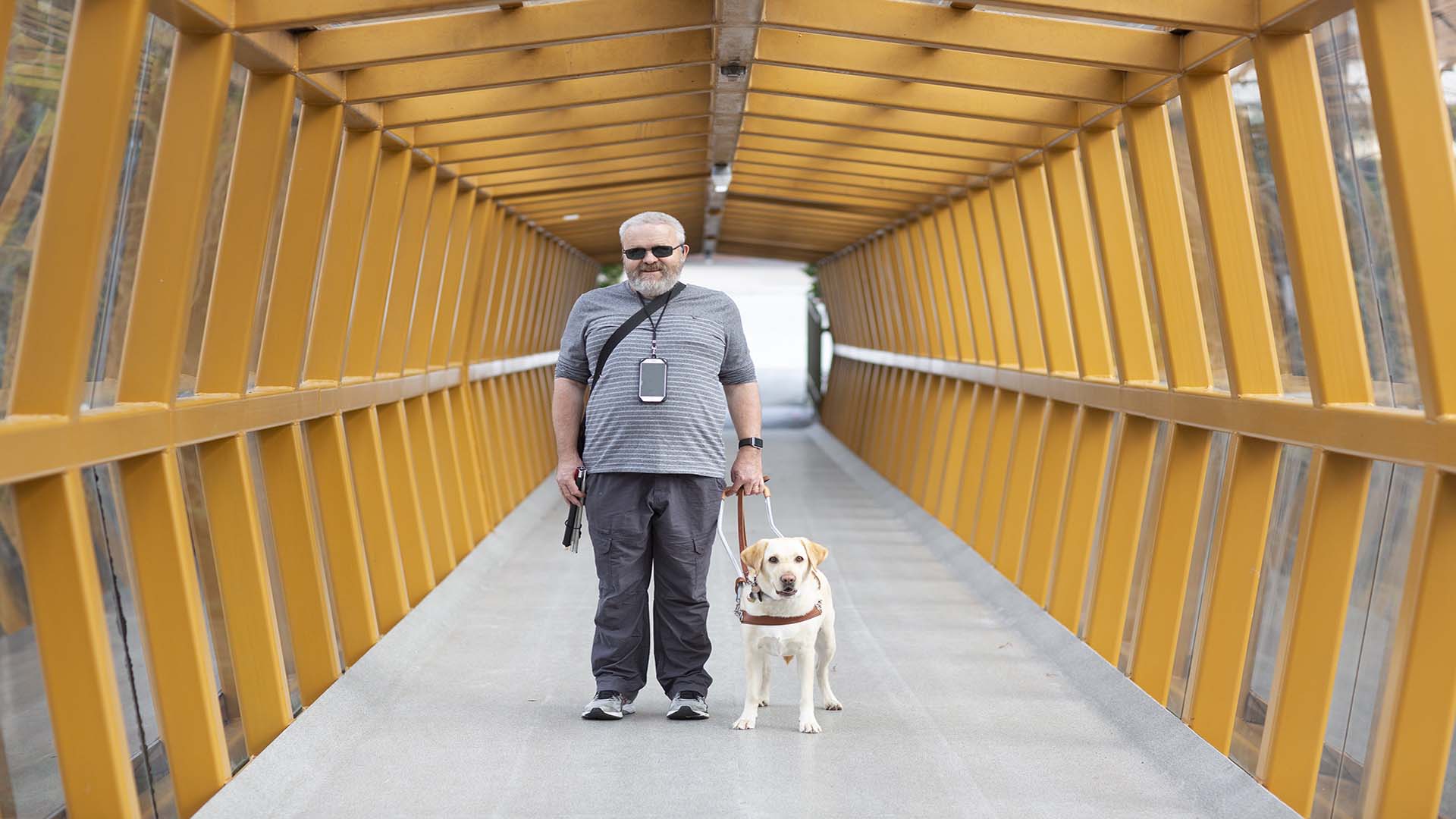
Keeping trust at the heart of technology
As we look to the future, we have a responsibility to ask ourselves not just what computers can do, but what they should do.
And, as we infuse intelligence into all of our digital experiences, we must stay committed to building trust into our technology. This includes built-in protections for privacy, security and compliance. The experience has to be transparent, as well as inclusive and impactful, so that more people can use and benefit from the technology.
Cyberthreats, in particular, are one of the biggest barriers to digital transformation today. In 2018, Microsoft partnered with leading IT analyst firm Frost & Sullivan to map the cybersecurity threats in Asia Pacific. The Study has found that the potential economic loss across Asia Pacific due to cyber security incidents is US$1.745 trillion, which is 7% of the region’s total GDP of US$24.33 trillion.
Microsoft invests more than US$1 billion annually on cybersecurity research and development globally and operates five Cybersecurity Centers in Asia Pacific. Located in China, India, Korea, Japan and Singapore, the centers are committed to maintaining a trusted and secure computing environment, which is a critical enabler for digital transformation.
We have also invested in two Microsoft Transparency Centers in Singapore and China. They enable government IT experts to review the source code of Microsoft products, access information on cybersecurity threats and vulnerabilities, and benefit from the expertise and insight of Microsoft security professionals
In Singapore, the Transparency Center and Cybersecurity Center, advances our worldwide commitment to driving transparency, security and trust in digital technologies.
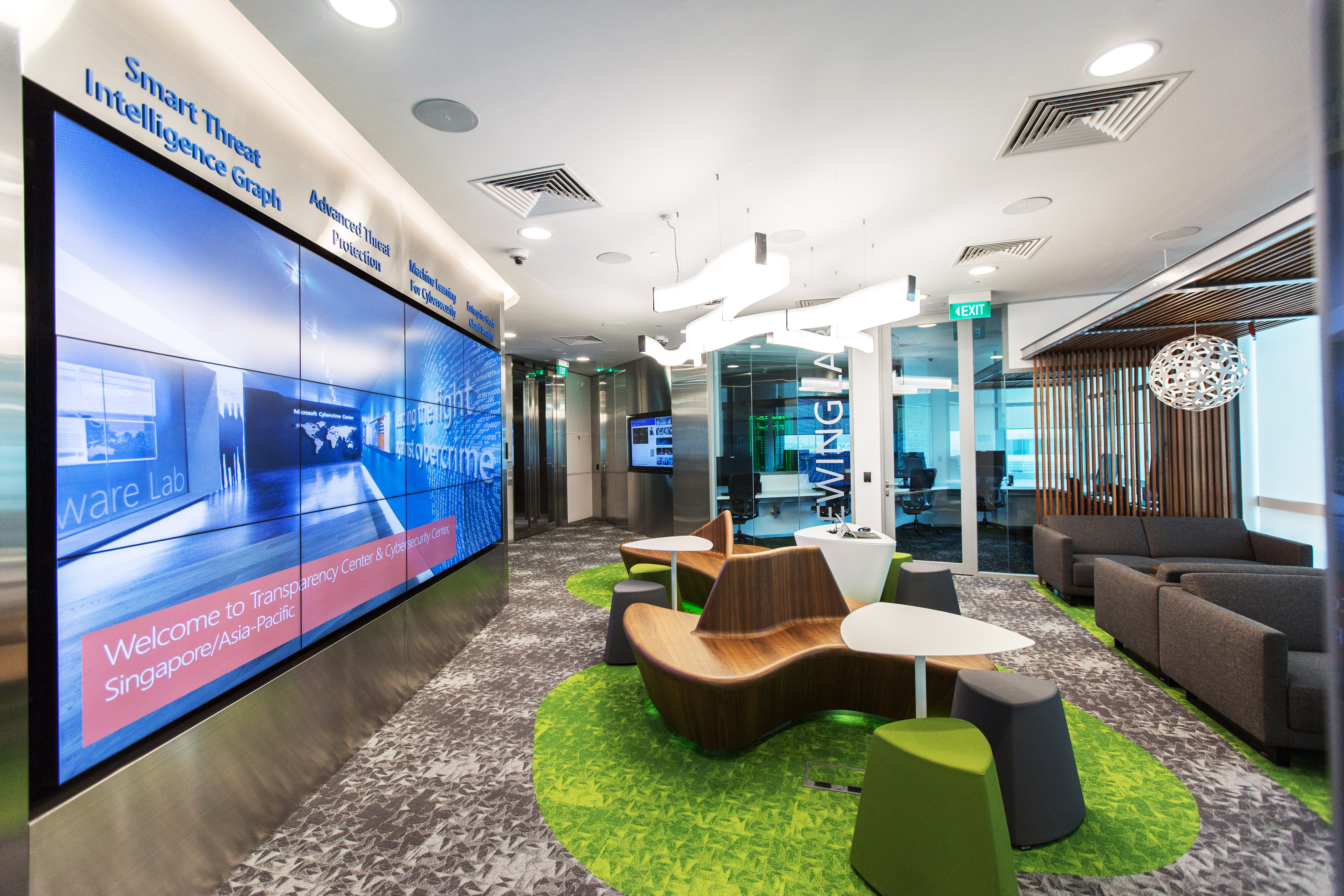
Microsoft Digital Crimes Unit members in the region actively collaborate with law enforcement agencies in the fight against digital crime by combining big data analytics, cutting-edge forensics and novel legal strategies to protect Microsoft’s customers and the Microsoft platform.
Empowering a digital revolution in Asia Pacific through reskilling
Advances in technology – like cloud computing and AI – are transforming our economy and the future of work. Digital transformation is creating both opportunities and challenges for industries, economies, and communities around the world. Jobs across all sectors increasingly require new technology skills, and some long-familiar occupations, in areas as diverse as healthcare and manufacturing, are being reinvented. The impact on people and their livelihoods is already significant.
Microsoft is committed to advancing a future that is for everyone. We believe everyone should have the opportunity to experience the benefits of technology and to participate in the creation of the new digital economy, because when everyone is empowered to achieve more, we all benefit.
Globally, and in Asia Pacific, we partner closely with nonprofits, governments, educators, and businesses to provide cash grants, technology, and resources to help ensure digital skills and computer science education are accessible to young people.
In Vietnam, Microsoft committed US$3 million in 2015 to help close the digital gap. We partnered with local authorities and nonprofits to equip underserved youth with digital skills through training, coaching, and education in cities and rural provinces. Through various programs, we have reached more than 150,000 Vietnamese youths, with 70 to 90 percent employment rate among those who participated in our career programs.
This includes the Enabling Boat project, a mobile classroom that brings modern technologies and computer science training to youth living in rural areas.
We have also kicked off Future Ready, an annual initiative we are running in partnership with nonprofits and schools to generate interest amongst students to learn computer science and build up relevant teaching capacity for educators. Over the next one year, Microsoft will empower close to 700,000 youth – particularly those from underserved communities – with opportunities to pursue their passion in computer science and enable more than 26,000 educators to teach high-quality and inclusive computer science across Asia Pacific.
Undeniably, our region’s workforce is at a critical inflection point. While we know that technology has created tremendous opportunity for added value jobs, we should be prepared for disruptions.
However, we are optimistic that technology will bring about transformation, not a displacement, as the roles would be transformed into better jobs. Looking at digital transformation’s impact on jobs, respondents for the IDC-Microsoft study felt that 85% of jobs will be transformed in the next three years due to digital transformation and 32% of the jobs in the market will be redeployed to higher value roles or reskilled to meet the needs of the digital age.
To address this, Microsoft announced two collaborations at the Times Higher Education World Academic Summit 2018. The first, with AI Singapore (AISG), will foster greater aptitude in AI among Singapore’s workforce, upskilling professionals, managers, executives, and technicians (PMETs) with AI knowledge. Microsoft will also work with the National University of Singapore (NUS), to harness the power of the Microsoft Academic Graph (MAG), hosted on Azure, to strengthen the university’s research capabilities.
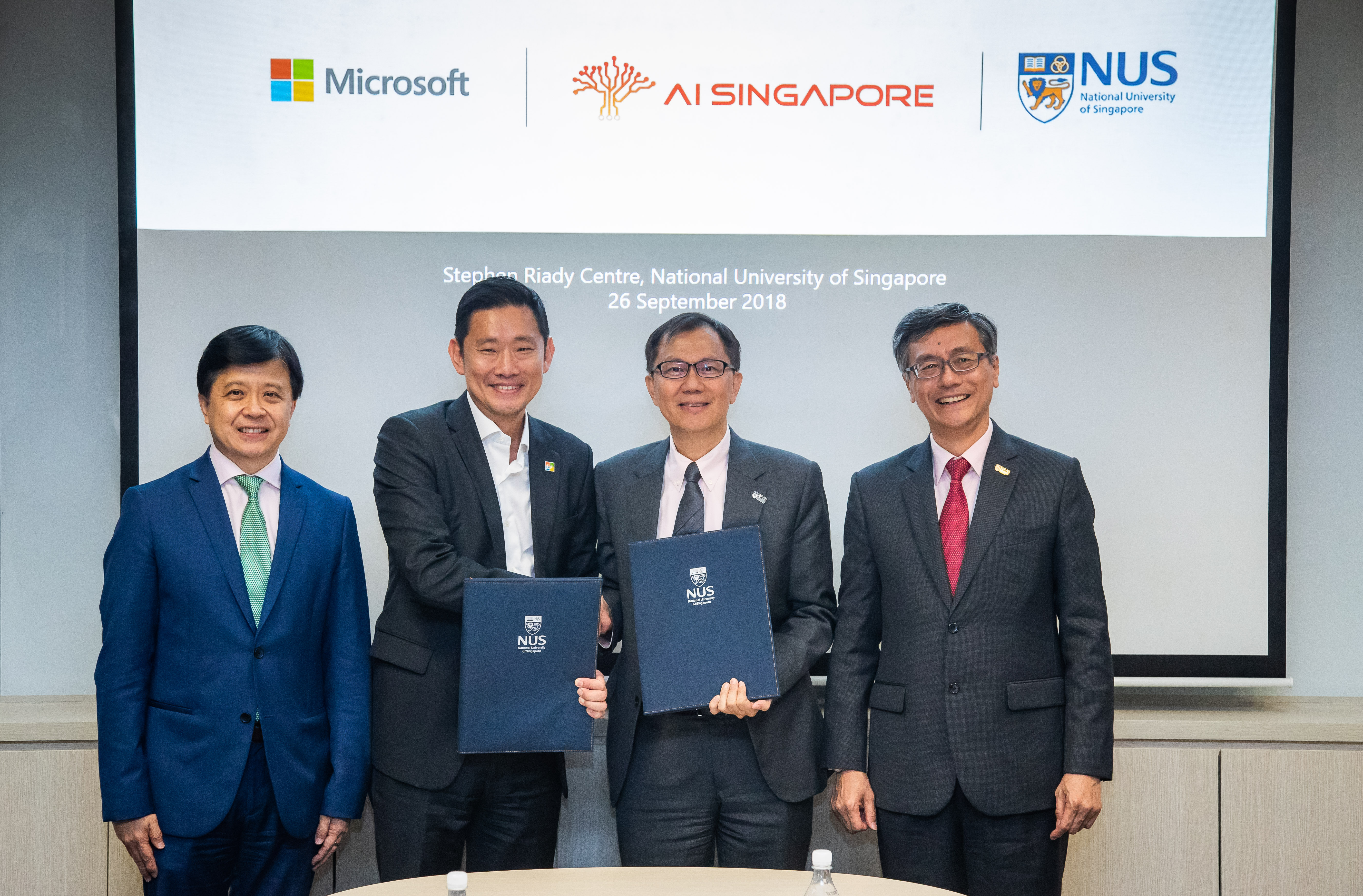
Microsoft has initiatives such as the Microsoft’s Digital Skills program that offers reskilling and conversion pathways that open doors to greater economic opportunity.
We launched a pilot for a reskilling program in South Australia targeting former workers from the automotive industry. They will undergo training to take up new jobs in the defense industry. The goal is to reskill 250,000 Australians by 2022.
At Microsoft Asia Pacific, we share the region’s vision of a digital future that is innovative, inclusive, trusted and competitive. Together with our network of employees, partners and customers, we hope to contribute to the next level of success in the Asia Pacific – one that looks set to be driven by digital transformation.





